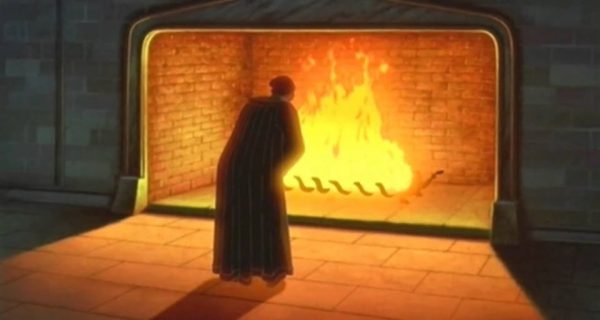What does a character need in order to be a convincing villain? Is it his words? His actions? How he evolves over the course of the story? In Disney’s animated film The Hunchback of Notre Dame, the main antagonist, Judge Claude Frollo, exudes an evil nature that chills the bones of the viewer. Not only do we see the manipulation and darkness of his mind, but we also see traces of humanity in the fictitious man.
The first moments of the movie introduce us to the character of Frollo, who immediately sets the viewer against him due to his cold and calculating nature. Due to his status as a judge, Frollo believes himself exempt from wrongdoing and condemnation. He persecutes the gypsies in the city solely based on their lifestyle and the fact they are not “proper citizens”; however, due to killing a gypsy woman and forcibly taking her child, Frollo ends up raising the boy and keeping him in Notre Dame’s bell tower.
Frollo never planned on having a ward, who we know as Quasimodo, but it was demanded of Frollo to keep the boy. Quasimodo is confined to the bell tower his whole life due to Frollo’s selfishness and guilt. He attempts to feed Quasimodo with lies about the gypsies, but for all Frollo’s desire for control, Quasimodo rebels. Frollo treats his ward with disguised contempt and constantly passively bullies Quasimodo into doing his bidding. Heaven forbid, too, if the public saw Quasimodo! In Frollo’s mind, it would be a reflection on him: what judge of Paris would have a hunchback living in the bell tower?
Despite being raised by a cruel man, Quasimodo is a kind and gentle soul. He somehow is the opposite of Frollo, and Frollo cannot stand it. As Frollo sets out to burn the gypsies out of Paris, he simultaneously forms an illicit attraction to a gypsy woman, Esmeralda. Even though The Hunchback of Notre Dame is technically categorized as a children’s film, Disney pushed the boundaries as far as possible with the content. Frollo has no reservations about his desire for Esmeralda; the song “Hellfire” makes that fact abundantly clear with hooded, faceless figures and images of Esmeralda dancing in a massive fireplace within Frollo’s abode. The sensuality and darkness of the scene might pass by children’s heads, but any teen and adult who watches it might shudder at the likeness with which Frollo portrays the way humanity handles temptation.
Frollo’s obsession with Esmeralda escalates as the film goes on, consuming him with thoughts of nothing else. He is blinded by power and anger, destroying everything in his path to possess a woman he cannot have, and the results are disastrous. Frollo believes he can have it all if he exercises enough power and force. Slowly, the people of Paris begin to turn against him, and in the end, Quasimodo does too. While it seems Frollo might win at the conclusion of the story, he falls to his death chasing after that which he coveted: Esmeralda and power. Too late did Frollo learn that pride goes before the fall and no one escapes judgement.
The intensity of the story of The Hunchback of Notre Dame is lessened to a degree in this movie, but underneath the feel-good songs and eye-catching characters and costumes, it portrays reality in a stark way. Frollo appears to represent what happens when we allow pride to rule our lives – it makes us blind to our faults and we pay one way or another in the end. Frollo is the quintessential villain: succumbing to the wickedness within until it snuffs out his life.
